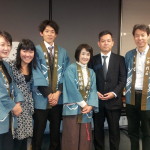WIT Life #253: Preserving Japanese Traditional Arts
WIT Life is a periodic series written by professional Writer/Interpreter/Translator Stacy Smith (Kumamoto-ken CIR, 2000-03). She starts her day by watching Fujisankei’s newscast in Japanese, and here she shares some of the interesting tidbits and trends along with her own observations.
This week I had the opportunity to interpret for a Japanese delegation comprised of two groups who traveled to New York to receive the annual Tiffany Foundation Award. This award was created by the Tiffany Foundation in collaboration with the Japan Center for International Exchange (JCIE), and it recognizes non-profits that are preserving Japanese traditional arts at the national and regional community levels. This year’s recipients were the Association for the Promotion of Ipponsugi Street, located in Ishikawa Prefecture, and envisi, located in Miyagi Prefecture. They were the 6th round of winners since the award’s establishment in late 2007.
The Association for the Promotion of Ipponsugi Street, whose members are featured here wearing the happi coats, preserves their city Nanao’s unique custom of 花嫁のれん (hanayome noren). Noren are long curtains that hang in the entrances to Japanese restaurants and traditional Japanese rooms, and the special bridal ones are dyed using the Kaga yuzen technique. Hanayome noren are hung in the doorway leading to the butsuma (a small room holding sacred objects) for the bride to walk through when she gets married, a ritual that symbolizes her being welcomed into her new family. The association organizes an annual exhibition displaying hanayome noren at local stores and residences, which has grown into a major tourist event. A traditional bridal procession takes place, and story telling booths are staffed by residents who introduce local culture and lifestyles.

The second winner was envisi, a group that uses the power of art to revitalize local communities by identifying and reevaluating hidden values and creating new bonds among people. In 2010 they organized a community-based project to make kiriko, a paper-cutting craft that applies unique techniques and designs that are passed down as tradition at local shrines. However, when the earthquake and tsunami hit on March 11, 2011, the town of Minamisanriku where envisi is based was one of the hardest hit areas, losing 70% of its buildings and many of its residents.
Currently the organization works on various art projects to support the people of Minamisanriku, such as a kiriko exhibit where artists interview local residents about their memories, experiences and hopes, and then design kiriko to tell their stories. envisi is also involved in children’s projects, working with local schools and hosting workshops where kids can create their own songs to tell their stories. Both groups actively engage with the younger generation, which is essential to insure that these valuable Japanese traditional crafts do not die out as the older generation does.


Comments are closed.